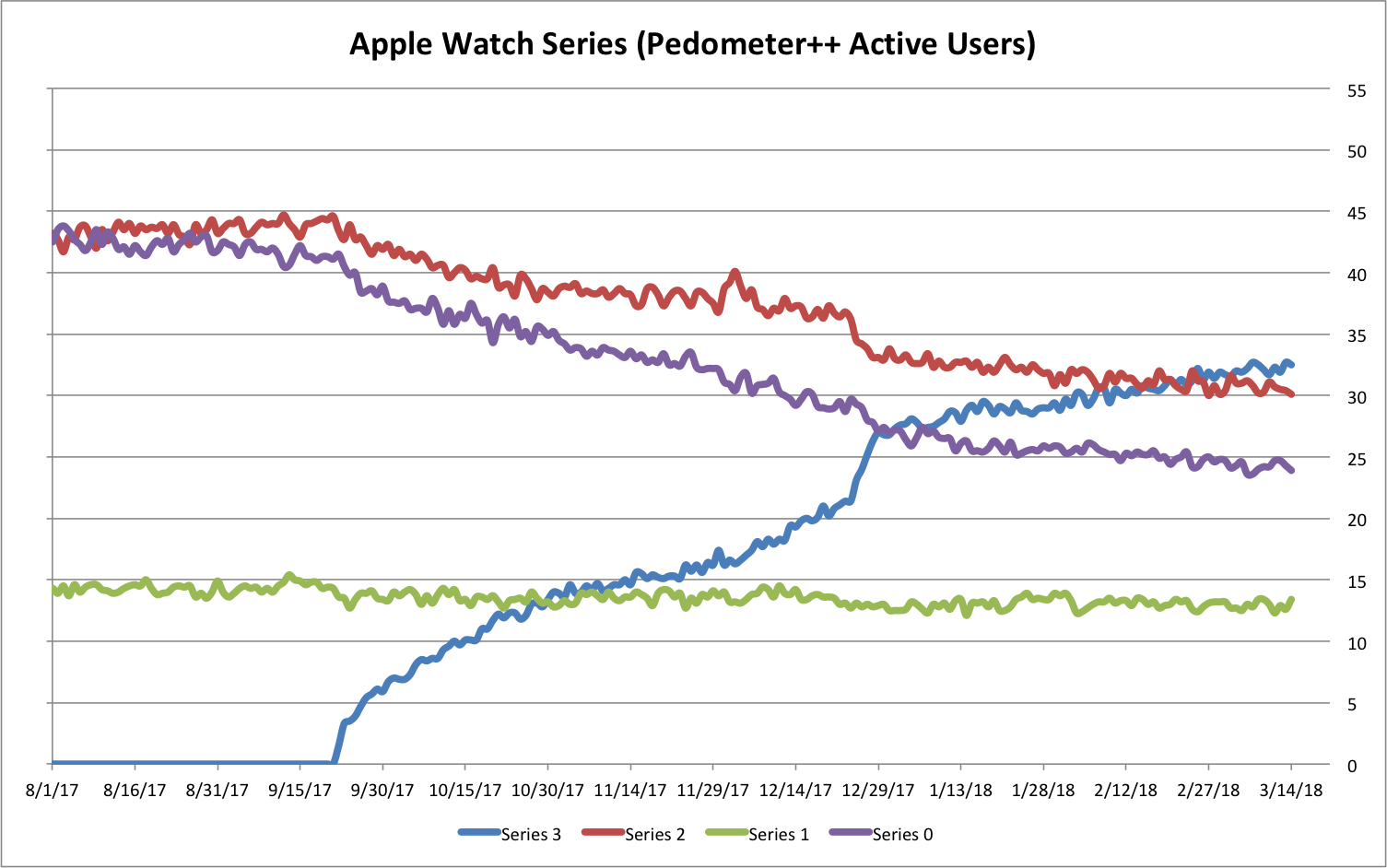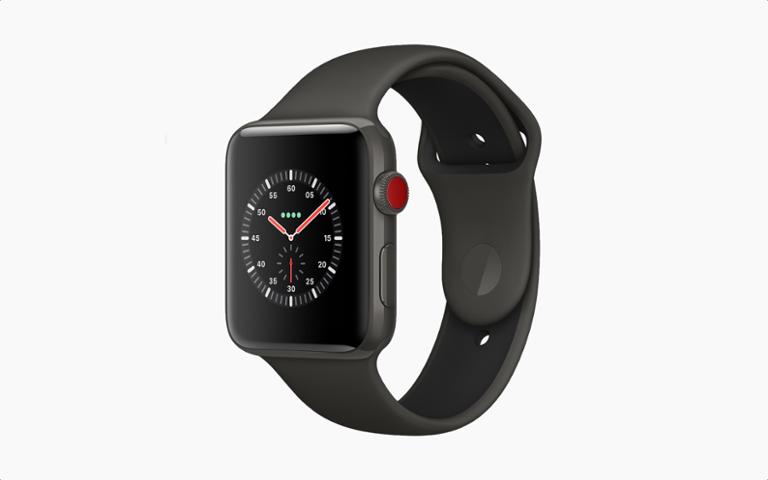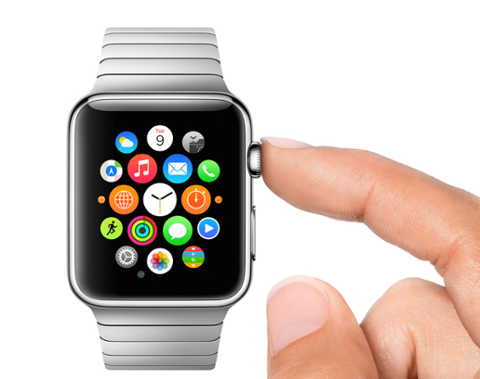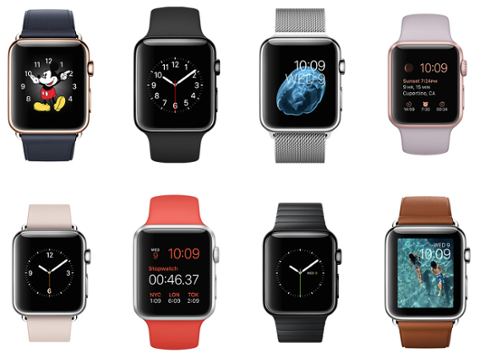 The Apple Watch Series 2 is a close second to Series 3, which feels quite natural. Oddly enough, the original – Series 0 – is in wider use than Series 1. To that, Smith hopes Apple moves to drop support for its oldest smartwatch soon, as it’s rough for developers. “I really do hope that they pursue this path,” he writes. “While as a consumer I know how bad it feels when something I use gets deprecated, as a developer I would love to see this platform be aggressively pushed forward.” The split between the 42mm and 38mm Apple Watch variants is 60/40, Smith adds. Even if Apple is selling one Apple Watch for every 10 iPhones, it’s far and away the most popular smartwatch around. It’s also indicative of why Apple won’t discuss sales. To admit only ten (or 12; we’re couching Smith’s numbers a bit to settle at a more round figure) percent of your base wants your latest and greatest product is tough. It’s especially difficult when the Apple Watch is being framed as a must-have health monitor. For developers, this is a good glimpse into whether or not the Apple Watch should be supported by your app. Distilling Smith’s findings a bit more, it’s worth examining the version of iOS that customers are using for your app or service to get a better idea of how many may have the Apple Watch. If you see a healthy percentage on older versions of iOS, it’s reasonable to assume they probably don’t have an Apple Watch. Smith’s findings arrive at a precarious time for Apple Watch. Many developers are openly questioning the utility of the platform, with many calling for native smartwatch apps to simply die. Fortunately, WWDC is just around the corner, and we should see what’s next for Apple Watch in June.
The Apple Watch Series 2 is a close second to Series 3, which feels quite natural. Oddly enough, the original – Series 0 – is in wider use than Series 1. To that, Smith hopes Apple moves to drop support for its oldest smartwatch soon, as it’s rough for developers. “I really do hope that they pursue this path,” he writes. “While as a consumer I know how bad it feels when something I use gets deprecated, as a developer I would love to see this platform be aggressively pushed forward.” The split between the 42mm and 38mm Apple Watch variants is 60/40, Smith adds. Even if Apple is selling one Apple Watch for every 10 iPhones, it’s far and away the most popular smartwatch around. It’s also indicative of why Apple won’t discuss sales. To admit only ten (or 12; we’re couching Smith’s numbers a bit to settle at a more round figure) percent of your base wants your latest and greatest product is tough. It’s especially difficult when the Apple Watch is being framed as a must-have health monitor. For developers, this is a good glimpse into whether or not the Apple Watch should be supported by your app. Distilling Smith’s findings a bit more, it’s worth examining the version of iOS that customers are using for your app or service to get a better idea of how many may have the Apple Watch. If you see a healthy percentage on older versions of iOS, it’s reasonable to assume they probably don’t have an Apple Watch. Smith’s findings arrive at a precarious time for Apple Watch. Many developers are openly questioning the utility of the platform, with many calling for native smartwatch apps to simply die. Fortunately, WWDC is just around the corner, and we should see what’s next for Apple Watch in June. Curious About Apple Watch Adoption Numbers? Check This Out.
The Apple Watch is clearly the best-selling smartwatch around. Still, Apple refuses to divulge just how many units have been sold. One developer’s findings might give us a good idea. David Smith has written thousands (literally) of iOS apps, spinning his more popular ‘++’ series of apps onto the wrist once Apple Watch launched; there’s Pedometer++, Workouts++, Sleep++, and Activity++. Leaning into his most popular app, Pedometer++, Smith was able to gather some interesting stats for Apple Watch. His admittedly fitness-thinking audience for iOS has translated into a 12 percent adoption rate for Apple Watch. If those numbers are a solid baseline for the iPhone/Apple Watch market overall, it shows both the reach of Apple Watch and the weakness of the wearables market. Series 3, the most recent iteration of Apple Watch, is also the most popular edition, according to Smith's data. Smith sees a split in adoption between the WiFi and cellular versions of the watch; cellular was a bit higher on launch, suggesting that version sold better than the WiFi variant at first, but use has evened out. It’s hard to know if a cellular Apple Watch without active service populates in his visualization as WiFi-only, though.  The Apple Watch Series 2 is a close second to Series 3, which feels quite natural. Oddly enough, the original – Series 0 – is in wider use than Series 1. To that, Smith hopes Apple moves to drop support for its oldest smartwatch soon, as it’s rough for developers. “I really do hope that they pursue this path,” he writes. “While as a consumer I know how bad it feels when something I use gets deprecated, as a developer I would love to see this platform be aggressively pushed forward.” The split between the 42mm and 38mm Apple Watch variants is 60/40, Smith adds. Even if Apple is selling one Apple Watch for every 10 iPhones, it’s far and away the most popular smartwatch around. It’s also indicative of why Apple won’t discuss sales. To admit only ten (or 12; we’re couching Smith’s numbers a bit to settle at a more round figure) percent of your base wants your latest and greatest product is tough. It’s especially difficult when the Apple Watch is being framed as a must-have health monitor. For developers, this is a good glimpse into whether or not the Apple Watch should be supported by your app. Distilling Smith’s findings a bit more, it’s worth examining the version of iOS that customers are using for your app or service to get a better idea of how many may have the Apple Watch. If you see a healthy percentage on older versions of iOS, it’s reasonable to assume they probably don’t have an Apple Watch. Smith’s findings arrive at a precarious time for Apple Watch. Many developers are openly questioning the utility of the platform, with many calling for native smartwatch apps to simply die. Fortunately, WWDC is just around the corner, and we should see what’s next for Apple Watch in June.
The Apple Watch Series 2 is a close second to Series 3, which feels quite natural. Oddly enough, the original – Series 0 – is in wider use than Series 1. To that, Smith hopes Apple moves to drop support for its oldest smartwatch soon, as it’s rough for developers. “I really do hope that they pursue this path,” he writes. “While as a consumer I know how bad it feels when something I use gets deprecated, as a developer I would love to see this platform be aggressively pushed forward.” The split between the 42mm and 38mm Apple Watch variants is 60/40, Smith adds. Even if Apple is selling one Apple Watch for every 10 iPhones, it’s far and away the most popular smartwatch around. It’s also indicative of why Apple won’t discuss sales. To admit only ten (or 12; we’re couching Smith’s numbers a bit to settle at a more round figure) percent of your base wants your latest and greatest product is tough. It’s especially difficult when the Apple Watch is being framed as a must-have health monitor. For developers, this is a good glimpse into whether or not the Apple Watch should be supported by your app. Distilling Smith’s findings a bit more, it’s worth examining the version of iOS that customers are using for your app or service to get a better idea of how many may have the Apple Watch. If you see a healthy percentage on older versions of iOS, it’s reasonable to assume they probably don’t have an Apple Watch. Smith’s findings arrive at a precarious time for Apple Watch. Many developers are openly questioning the utility of the platform, with many calling for native smartwatch apps to simply die. Fortunately, WWDC is just around the corner, and we should see what’s next for Apple Watch in June.
 The Apple Watch Series 2 is a close second to Series 3, which feels quite natural. Oddly enough, the original – Series 0 – is in wider use than Series 1. To that, Smith hopes Apple moves to drop support for its oldest smartwatch soon, as it’s rough for developers. “I really do hope that they pursue this path,” he writes. “While as a consumer I know how bad it feels when something I use gets deprecated, as a developer I would love to see this platform be aggressively pushed forward.” The split between the 42mm and 38mm Apple Watch variants is 60/40, Smith adds. Even if Apple is selling one Apple Watch for every 10 iPhones, it’s far and away the most popular smartwatch around. It’s also indicative of why Apple won’t discuss sales. To admit only ten (or 12; we’re couching Smith’s numbers a bit to settle at a more round figure) percent of your base wants your latest and greatest product is tough. It’s especially difficult when the Apple Watch is being framed as a must-have health monitor. For developers, this is a good glimpse into whether or not the Apple Watch should be supported by your app. Distilling Smith’s findings a bit more, it’s worth examining the version of iOS that customers are using for your app or service to get a better idea of how many may have the Apple Watch. If you see a healthy percentage on older versions of iOS, it’s reasonable to assume they probably don’t have an Apple Watch. Smith’s findings arrive at a precarious time for Apple Watch. Many developers are openly questioning the utility of the platform, with many calling for native smartwatch apps to simply die. Fortunately, WWDC is just around the corner, and we should see what’s next for Apple Watch in June.
The Apple Watch Series 2 is a close second to Series 3, which feels quite natural. Oddly enough, the original – Series 0 – is in wider use than Series 1. To that, Smith hopes Apple moves to drop support for its oldest smartwatch soon, as it’s rough for developers. “I really do hope that they pursue this path,” he writes. “While as a consumer I know how bad it feels when something I use gets deprecated, as a developer I would love to see this platform be aggressively pushed forward.” The split between the 42mm and 38mm Apple Watch variants is 60/40, Smith adds. Even if Apple is selling one Apple Watch for every 10 iPhones, it’s far and away the most popular smartwatch around. It’s also indicative of why Apple won’t discuss sales. To admit only ten (or 12; we’re couching Smith’s numbers a bit to settle at a more round figure) percent of your base wants your latest and greatest product is tough. It’s especially difficult when the Apple Watch is being framed as a must-have health monitor. For developers, this is a good glimpse into whether or not the Apple Watch should be supported by your app. Distilling Smith’s findings a bit more, it’s worth examining the version of iOS that customers are using for your app or service to get a better idea of how many may have the Apple Watch. If you see a healthy percentage on older versions of iOS, it’s reasonable to assume they probably don’t have an Apple Watch. Smith’s findings arrive at a precarious time for Apple Watch. Many developers are openly questioning the utility of the platform, with many calling for native smartwatch apps to simply die. Fortunately, WWDC is just around the corner, and we should see what’s next for Apple Watch in June. 

